Division of Lacustrine Environment and Significance for Shale Oil Exploration: A Case Study of the Third Member of Shahejie Formation in Dongying Sag
Abstract
1. Introduction
2. Materials and Methods
2.1. Geological Settings
2.2. Data Collection
2.3. Calculation Formula of Aqueous Medium Characteristics
2.4. Analysis Method
3. Results
3.1. Basis and Scheme of Environmental Division
3.2. Environmental Zone and Characteristics
3.3. Division Characteristics of Key Coring Wells
4. Discussion
4.1. Advantage Storage Space of Shale Oil Reservoirs
4.2. Prediction of Favorable Zones for Shale Oil Carbonate Reservoirs
5. Conclusions
- Establishing a classification scheme for the aqueous medium environment of Es3 is based on the salinity boundaries of 4‰ and 11‰ and pH boundaries of 8.65 and 8.85 for defining high, medium, and low levels. There are nine kinds of zones theoretically proposed by the superposition method to describe the salinity and pH.
- Es3L is dominated by areas with high salinity–middle pH and middle salinity–high pH, which are rich in carbonate, presenting a saline–brackish alkaline environment. The salinity and pH in Es3M decreased, mainly in middle salinity–middle pH and low salinity–middle pH areas, which were in the brackish neutral environment. Es3U is mainly characterized by low salinity and low pH conditions.
- The abundant laminar carbonate mineral interbeds serve as effective reservoir spaces. The limestone content in zones with high salinity–middle pH, middle salinity–high pH, and middle salinity–high pH mostly remains above 35%, suggesting these areas as favorable for shale oil reservoirs in the Es3 Member of the Dongying Sag. It is concentrated in the central part of Es3L, the western and northeast parts of the Lijin Sub-Sag, and the northern gentle slope of the Guangrao. The first two environmental partitions are located in the structural slope area, which is a valuable reserve target for the exploration and development of shale oil.
Author Contributions
Funding
Data Availability Statement
Acknowledgments
Conflicts of Interest
Abbreviations
| Es3 | The third member of the Shahejie Formation |
| Es3L | The lower part of the third member of the Shahejie Formation |
| Es3M | The middle part of the third member of the Shahejie Formation |
| Es3U | The upper part of the third member of the Shahejie Formation |
| Es4U | The upper part of the fourth member of the Shahejie Formation |
| TOC | Total Organic Carbon |
References
- Zou, C.N.; Ma, F.; Pan, S.G.; Zhang, X.S.; Wu, S.T.; Fu, G.Y.; Wang, H.J.; Yang, Z. Formation and distribution potential of global shale oil and the developments of continental shale oil theory and technology in China. Earth Sci. Front. 2023, 30, 128–142. [Google Scholar]
- Salygin, V.; Guliev, I.; Chernysheva, N.; Sokolova, E.; Toropova, N.; Egorova, L. Global shale revolution: Successes, challenges, and prospects. Sustainability 2019, 11, 1627. [Google Scholar] [CrossRef]
- Kuang, L.C.; Hou, L.H.; Yang, Z.; Wu, S. Key parameters and methods of lacustrine shale oil reservoir characterization. Acta Pet. Sin. 2021, 42, 1–14. [Google Scholar]
- Zhao, X.Z.; Pu, X.G.; Jiang, W.Y.; Zhou, L.; Jin, F.; Xiao, D.; Fu, L.; Li, H. An exploration breakthrough in Paleozoic petroleum system of Huanghua Depression in Dagang Oilfield and its significance, North China. Pet. Explor. Dev. 2019, 46, 651–663. [Google Scholar] [CrossRef]
- Fu, J.H.; Li, S.; Guo, Q.; Guo, W.; Zhou, X.; Liu, J. Enrichment condition and favorable area optimization of continental shale oil in Ordos Basin. Acta Pet. Sin. 2022, 43, 1702. [Google Scholar]
- Sun, L.; Liu, H.; He, W.; Li, G.; Zhang, S.; Zhu, R.; Jin, X.; Meng, S.; Jiang, H. An analysis of major scientific problems and research paths of Gulong shale oil in Daging Oilfield, NE China. Pet. Explor. Dev. 2021, 48, 453–463. [Google Scholar] [CrossRef]
- He, W.; Meng, Q.; Feng, Z.; Zhang, J.; Wang, R. In-situ accumulation theory and exploration & development practiceof Gulong shale oil in Songliao Basin. Acta Pet. Sin. 2022, 43, 1–14. [Google Scholar]
- Li, G.; Zhu, R.; Zhang, Y.; Chen, Y.; Cui, J.; Jiang, Y.; Wu, K.; Sheng, J.; Xian, C.; Liu, H. Geological characteristics, evaluation criteria and discovery significance of Paleogene Yingxiongling shale oil in Qaidam Basin, NW China. Pet. Explor. Dev. 2022, 49, 18–31. [Google Scholar] [CrossRef]
- Kuang, L.C.; Dong, D.; He, W.Y.; Wen, S.; Sun, S.; Li, S.X.; Qiu, Z.; Liao, X.W.; Li, Y.; Wu, J.; et al. Geological characteristics and development potential of transitional shale gas in the east margin of the Ordos Basin, NW China. Pet. Explor. Dev. 2020, 47, 435–446. [Google Scholar] [CrossRef]
- Liu, H.M.; Wang, Y.; Yang, Y.H.; Zhang, S. Sedimentary Environment and Lithofacies of Fine-Grained Hybrid Sedimentary in Dongying Sag: A Case of Fine-Grained Sedimentary System of the Es4. Earth Sci. 2020, 45, 3543–3555. [Google Scholar]
- Yang, W.; Wang, X.; Ding, J.; Wang, Y. Characteristics and control factors of fine-grained sedimentary rock lithofacies in Bonan subsag. J. China Univ. Min. Technol. 2017, 46, 365–374. [Google Scholar]
- Zhang, Q.; Zhu, X.; Li, C.; Qiao, L. Classification and quantitative characterization of microscopic pores in organic-rich shale of the Shahejie Formation in the Zhanhua Sag, Bohai Bay Basin. Oil Gas Geol. 2014, 35, 286–294. [Google Scholar]
- Zhang, S.; Liu, H.M.; Zhang, P.F.; Li, L.J.; Liu, X.J.; Song, X.Q.; Wei, X.L.; Wang, Y.; Wang, W.Q. Geological characteristics of shale oil enrichment in Niuzhuang sag, Dongying depression. J. China Univ. Min. Technol. 2022, 51, 1138–1151. [Google Scholar]
- Hao, Y.; Chen, F.; Zhu, J.; Zhang, S. Reservoir space of the Es33-Es41 shale in Dongying Sag. Int. J. Min. Sci. Technol. 2014, 24, 425–431. [Google Scholar] [CrossRef]
- Zhang, S.; Chen, S.; Tan, M.; Zhang, Y.; Sun, B.; Gong, W.; Hu, Z.; Hou, Z. Characterization of sedimentary microfacies of shale in the lower third sub-member of Shahejie Formation, western Dongying sag. Acta Pet. Sin. 2014, 35, 633–645. [Google Scholar]
- Wang, Y.; Song, G.Q.; Liu, H.M.; Jiang, X.F.; Hao, X.F.; Ning, F.X.; Zhu, S.D.; Lin, L. Main control factors of enrichment characteristics of shale oil in Jiyang depression. Pet. Geol. Recovery Effic. 2015, 22, 20–25. [Google Scholar]
- Sun, C.; Yao, S.; Li, J.; Liu, B. The Characterization of Shale Oil Reservoir in Dongying Sag. Geol. Rev. 2016, 62, 1497–1510. [Google Scholar]
- Bai, C.Y. The Genesis of Laminar Carbonates from Jiyang Sub-Basin and Their Implicate for Shale Oil Accumulation; China University of Gcosciences (Beijing): Beijing, China, 2019. [Google Scholar]
- Burton, G.R.; Woolf, K.; Sullivan, B. Lacustrine depositional environments in the Green River Formation,Uinta Basin: Expression in outcrop and wire line logs. AAPG Bull. 2014, 98, 1699–1715. [Google Scholar] [CrossRef]
- Scherer, C.M.S.; Goldberg, K.; Bardola, T. Facies architecture and sequence stratigraphy of an early post-rift fluvial succession,Aptian Brabalha Formation,Araripe Basin,northeastern Brazil. Sediment. Geol. 2015, 322, 43–62. [Google Scholar] [CrossRef]
- Merkel, A.; Fink, R.; Littke, R. High pressure methane sorption characteristics of lacustrine shale from the Midland Valley Basin, Scotland. Fuel 2016, 182, 361–372. [Google Scholar] [CrossRef]
- Moradi, A.V.; Sari, A.; Akkaya, P. Paleoredox reconstruction of biturninous shales from the Miocene Hancili Formation, cankiri-corum Basin, Turkey: Evaluating the role of an oxia in accumulation of organic-rich shales. Mar. Pet. Geol. 2016, 78, 136–150. [Google Scholar] [CrossRef]
- Yang, T.; Cao, Y.; Friis, H.; Wang, Y.; Zhou, L. Diagenetic evolution and chemical changes of deep-water mudstones of Shahejie Formation in the Dongying Sag, Jiyang Depression, Eastern China. Mar. Pet. Geol. 2018, 93, 14–32. [Google Scholar] [CrossRef]
- Sun, C.; Yao, S.; Li, J.; Liu, B. Characteristics of Mesoporous in shale oil reservoirs by Small Angle X-ray Scattering Method. Geol. J. China Univ. 2017, 24, 715–724. [Google Scholar]
- Zou, C.; Yang, Z.; Cui, J.; Zhu, R.; Hou, L.; Tao, S.; Yuan, X.; Wu, S.; Lin, S.; Wang, L.; et al. Formation mechanism,geological characteristics and development strategy of nonmarine shale oil in China. Pet. Explor. Dev. 2013, 40, 14–26. [Google Scholar] [CrossRef]
- Wang, G.M.; Lin, G.S. Eogene paleoclimate zone study in the Jiyang depression. Bulletin of Mineralogy. Petrol. Geochem. 2012, 31, 505–509. [Google Scholar]
- Liu, H.M.; Zhang, S.; Bao, S.Y.; Fang, Z.; Yao, S.; Wang, Y. Geological characteristics and effectiveness of the shaleoil reservoir in Dongying sag. Oil Gas Geol. 2019, 40, 512–523. [Google Scholar]
- Teng, J.B.; Liu, H.M.; Qiu, L.W.; Zhang, S.P.; Fang, Z.W.; Li, B.; Zhang, S.; Miao, Z.W. Characteristics and influencing factors of shale oil reservoir space in Paleogene shale of Dongying Sag. Earth Sci. 2022. [Google Scholar]
- Fang, Z.W.; Zhang, S.P.; Liu, H.M. Bedding structure characteristics and the storage controlling factors of mud-shale in Upper Es4 to Lower Es3 Members in Jiyang Depression. Pet. Geol. Recovery Effic. 2019, 26, 101–108. [Google Scholar]
- Wang, G.M.; Xiong, Z.H.; Zhang, J.; Fu, Y. The correspondence between the aragonite content of Palaeogene shale and the thermal evolution of source rocks in Jiyang depression. Acta Pet. Sin. 2017, 38, 855–862. [Google Scholar]
- Wang, Y.; Liu, H.; Song, G.; Hao, X.; Zhu, D.; Zhu, D.; Ding, J.; Yang, W.; Yin, Y. Carbonate genesis and geological significance of shale hydrocarbon in lacustrine facies mud shale: A case study of source rocks in the upper sub-member of Member4 and lower sub-member of Member 3 of Shahejie Formation, Dongying sag. Acta Pet. Sin. 2017, 38, 1390–1400. [Google Scholar]
- Kong, X.X. Sedimentary Characteristics, Origin and Hydrocarbon Accumulation of Lacustrine Carbonate-Bearing Fine Grained Sedimentary Rocks; China University of Gcosciences (Beijing): Beijing, China, 2020. [Google Scholar]
- Wang, A.H.; Ye, S.Y.; Liu, J.K.; Ding, X.G.; Li, H.L.; Xu, N.C. Discrimination between Marine and Terrestrial Sedimentary Environments by the Selectively Extracted Sr/Ba Ratio: A case of sediments in the Yellow River Delta. ACTA Sedimentolocica Sin. 2020, 38, 1226–1238. [Google Scholar]
- Chen, C.Q. A Study on the Diagenesis of Paleogene System Based on Sequence Framework in DongYing Sag; China University of Gcosciences (Beijing): Beijing, China, 2006. [Google Scholar]
- Jiang, Z.; Li, T.; Gong, H.; Jiang, T.; Chang, J.; Ning, C.; Su, S.; Chen, W. Characteristics of low-mature shale reservoirs in Zhanhua sag and theirinfluence on the mobility of shale oil. Acta Pet. Sin. 2020, 41, 1587–1600. [Google Scholar]
- Zhang, S. Shale Oil Enrichment Elements and Geological Dessert Types in Jiyang Depression. Sci. Technol. Eng. 2021, 21, 504–511. [Google Scholar]
- Tian, J.C.; Lin, X.B.; Zhang, X.; Peng, S.; Yang, C.; Luo, S.; Xu, L. The genetic mechanism of shoal facies dolomite and its additive effect of Permian Qixia Formation in Sichuan Basin. Acta Petrol. Sin. 2014, 30, 679–686. [Google Scholar]
- Yu, T. Enrichment Characteristics and the Prediction of Favorable Target Areas of Shale Oil in Dongying Sag; China University of Petroleum (East China): Qingdao, China, 2018. [Google Scholar]
- Yu, Y.J.; Wang, H.Y.; Liu, D.X.; Zhao, Q.; Zheng, M.; Wang, S.J. Probing and Thinking on “Exploring Petroleum Inside Source Kitchen” of Continental Shale Oil Exploration—A Case Study of the First Member of Shahejie Formation in Qikou Sag, Bohai Bay Basin, China. J. Earth Sci. Environ. 2021, 43, 117–134. [Google Scholar]
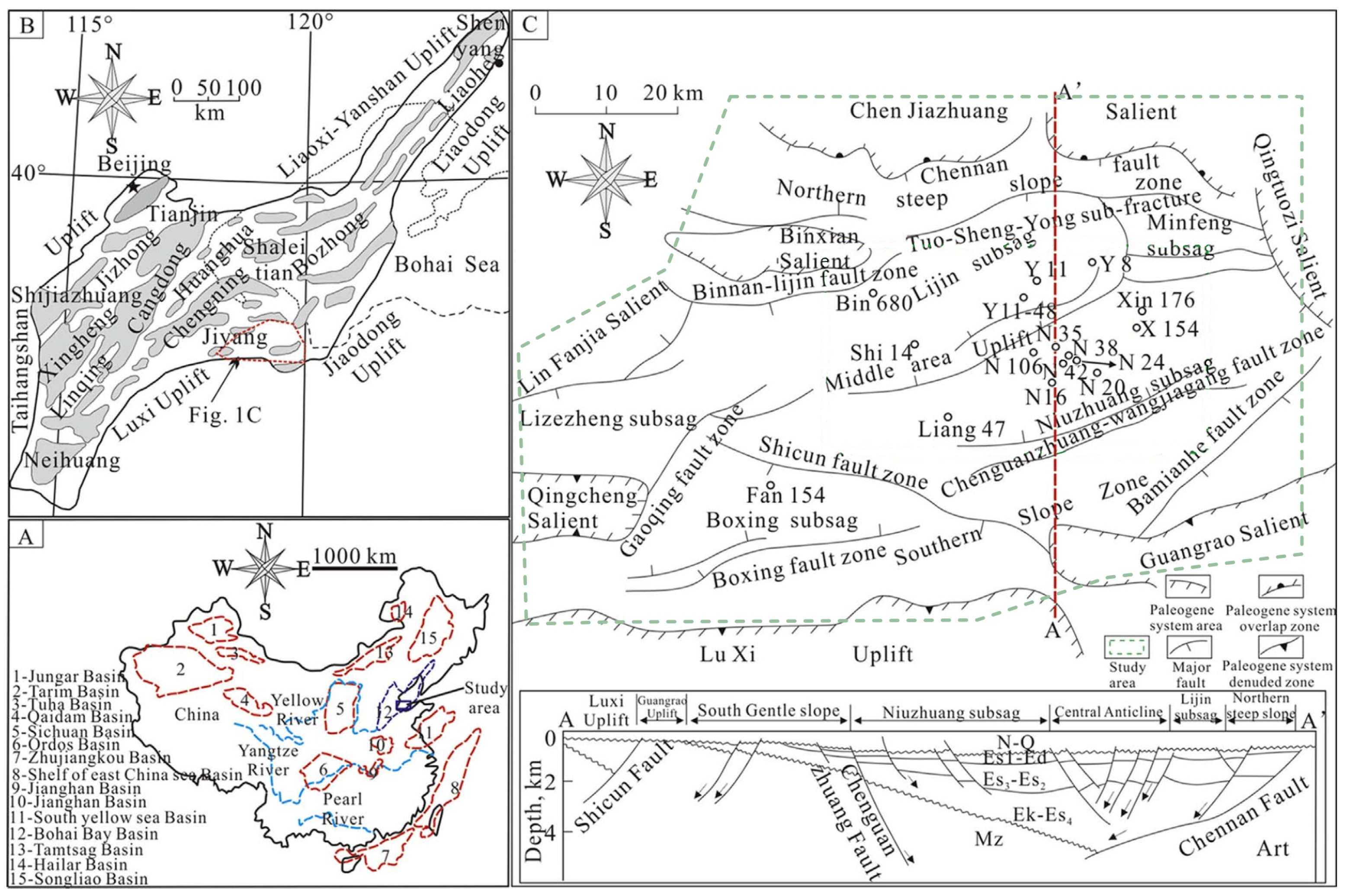
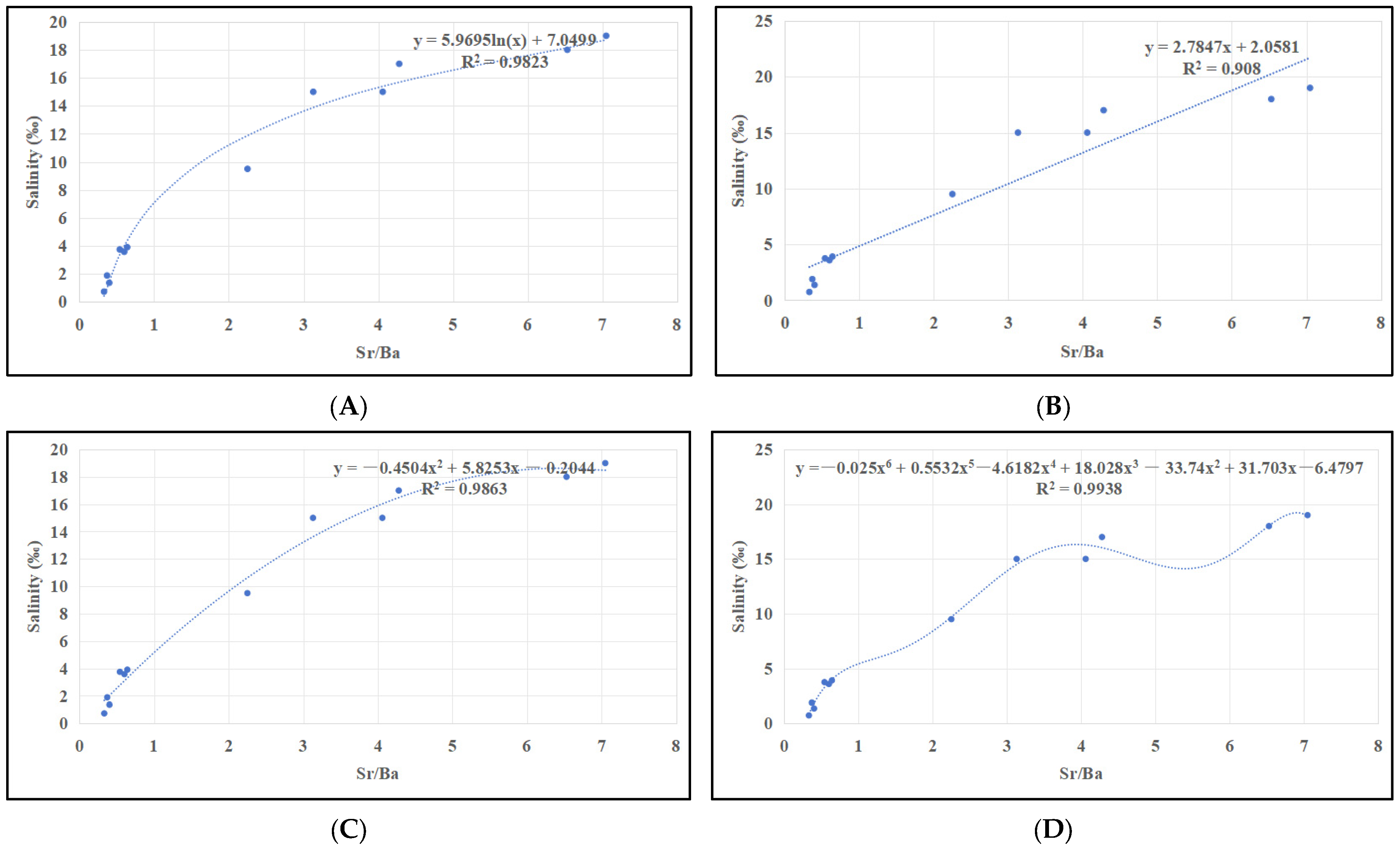


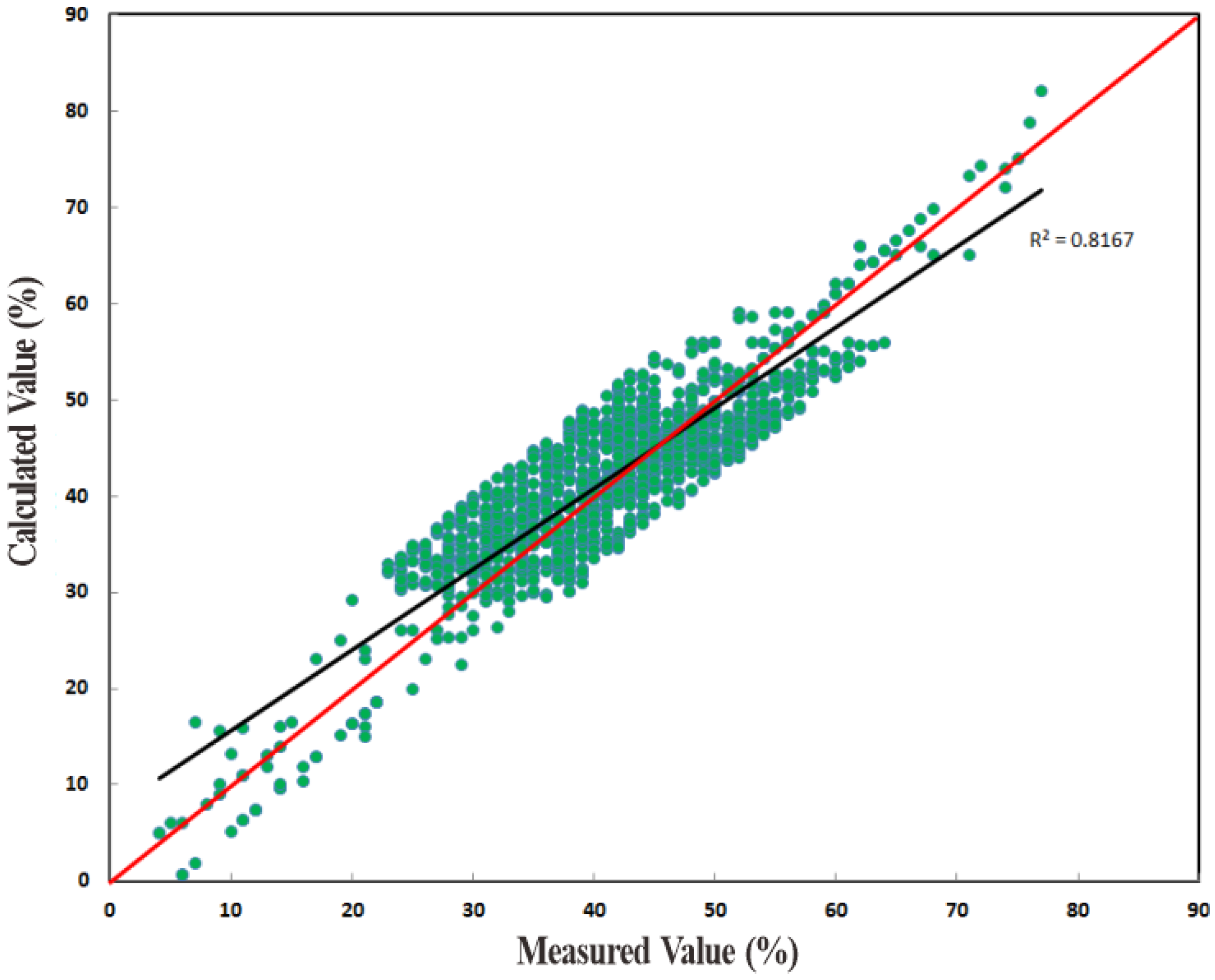
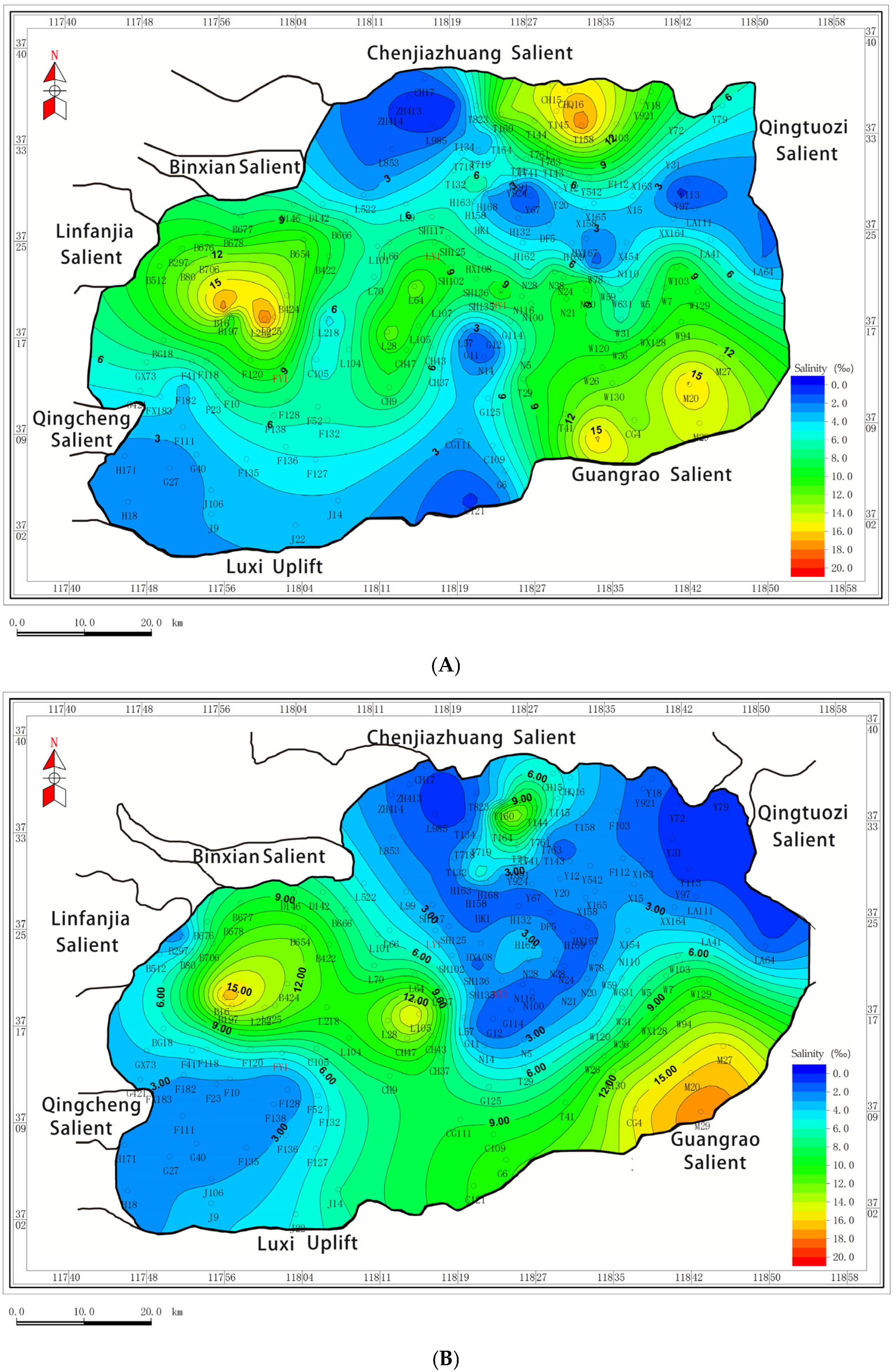
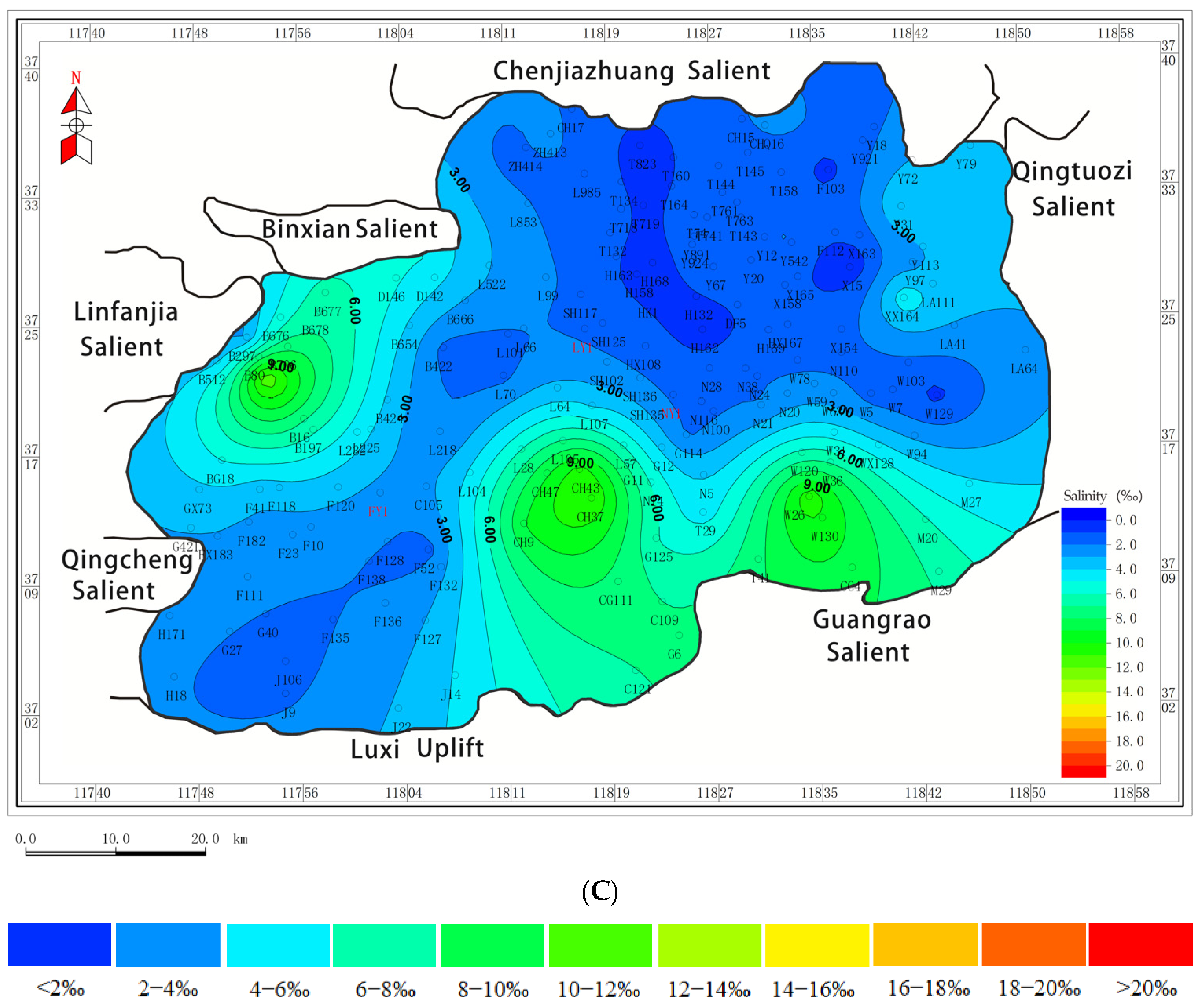

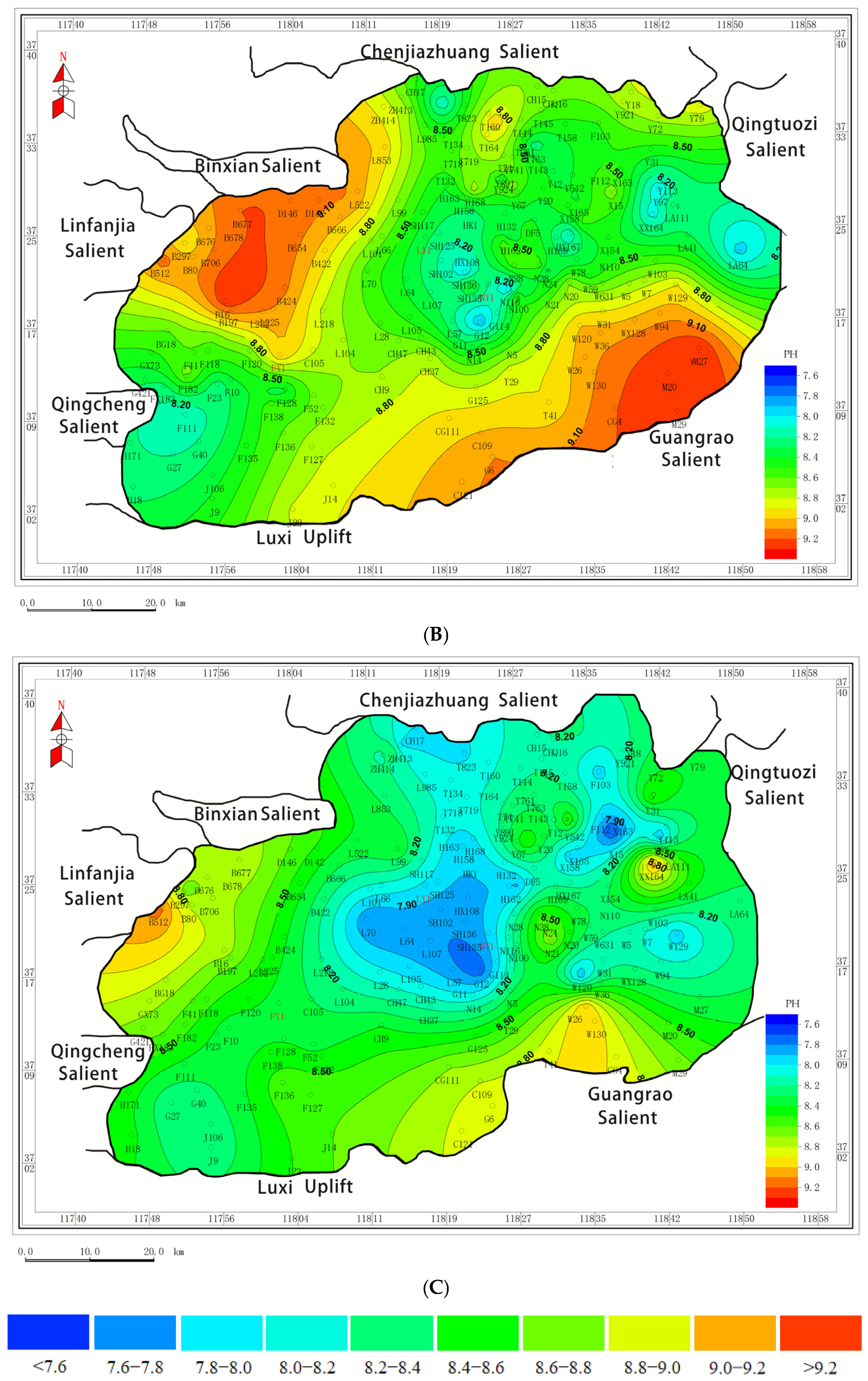
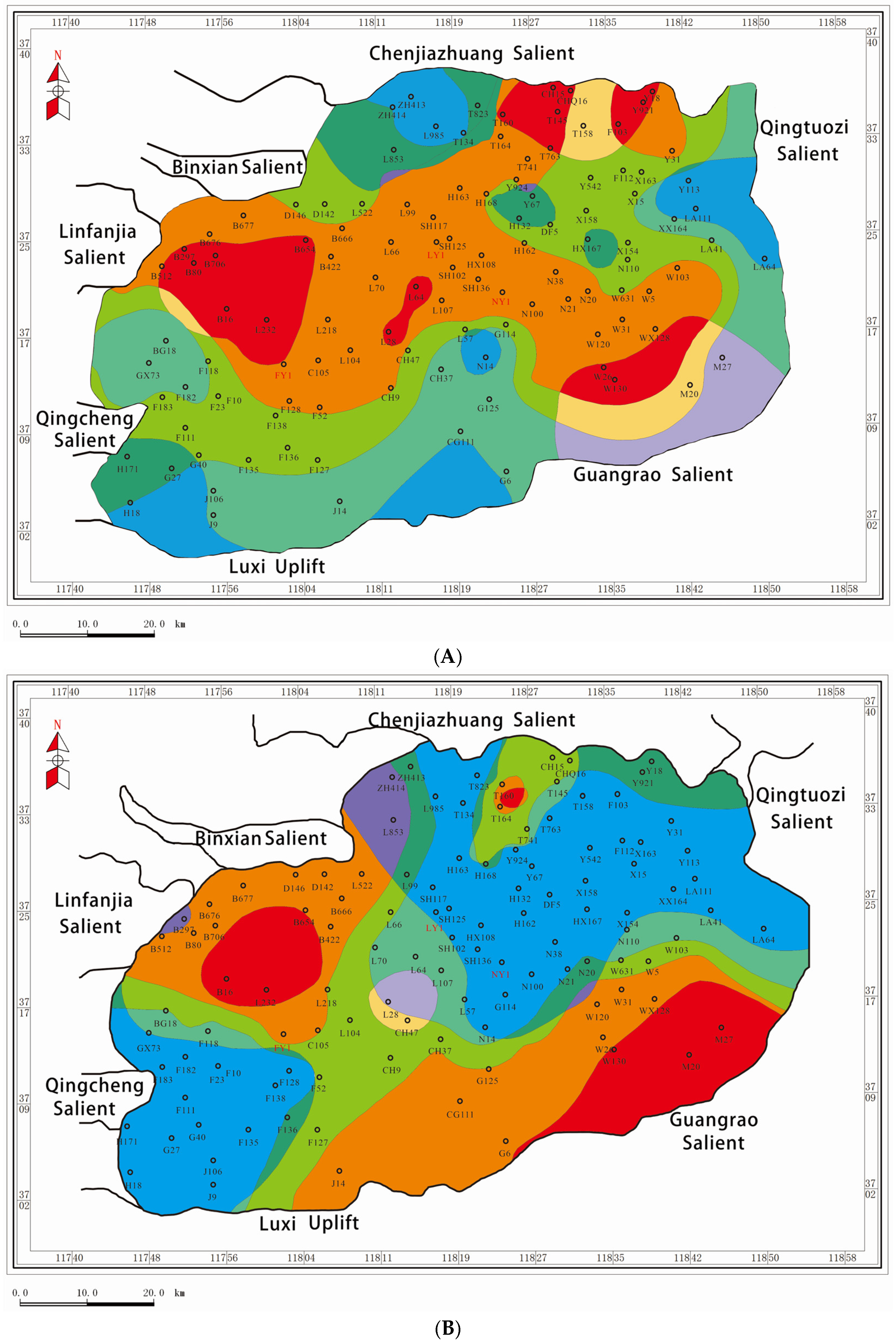

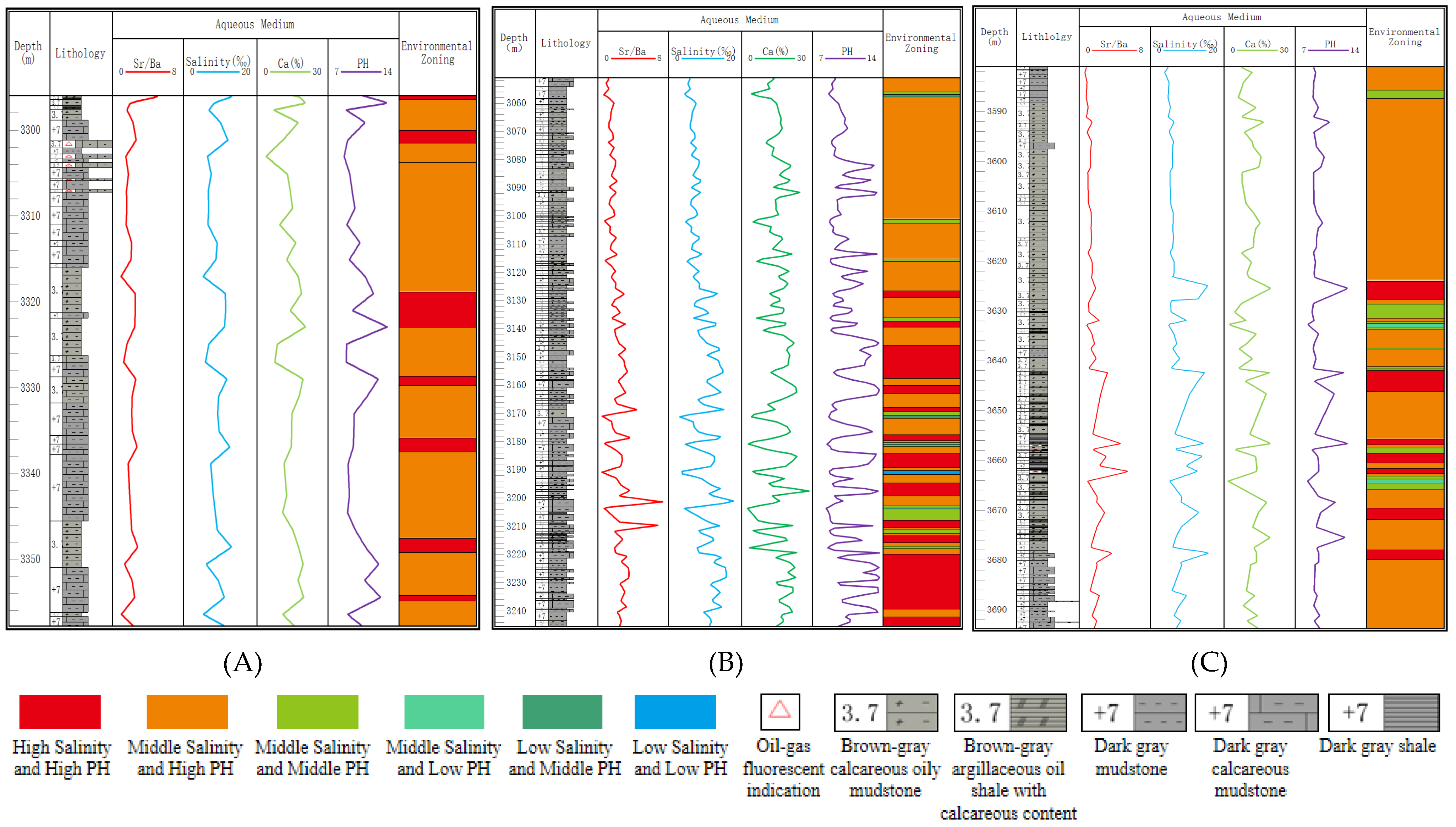
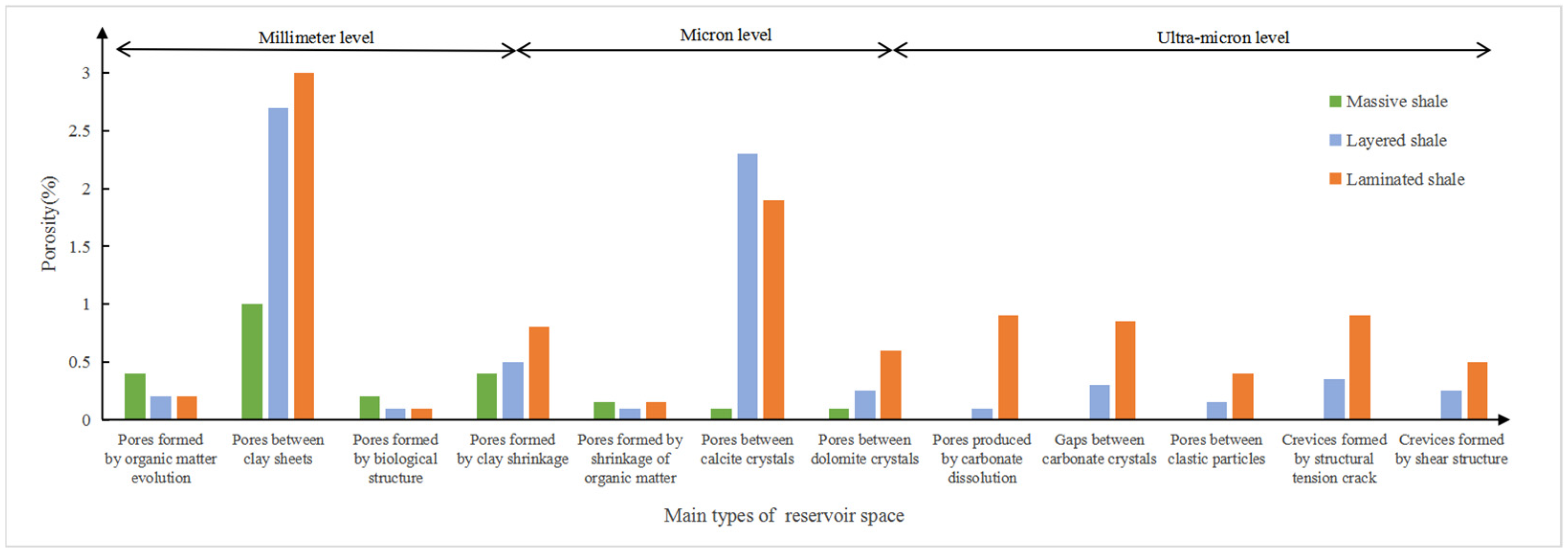
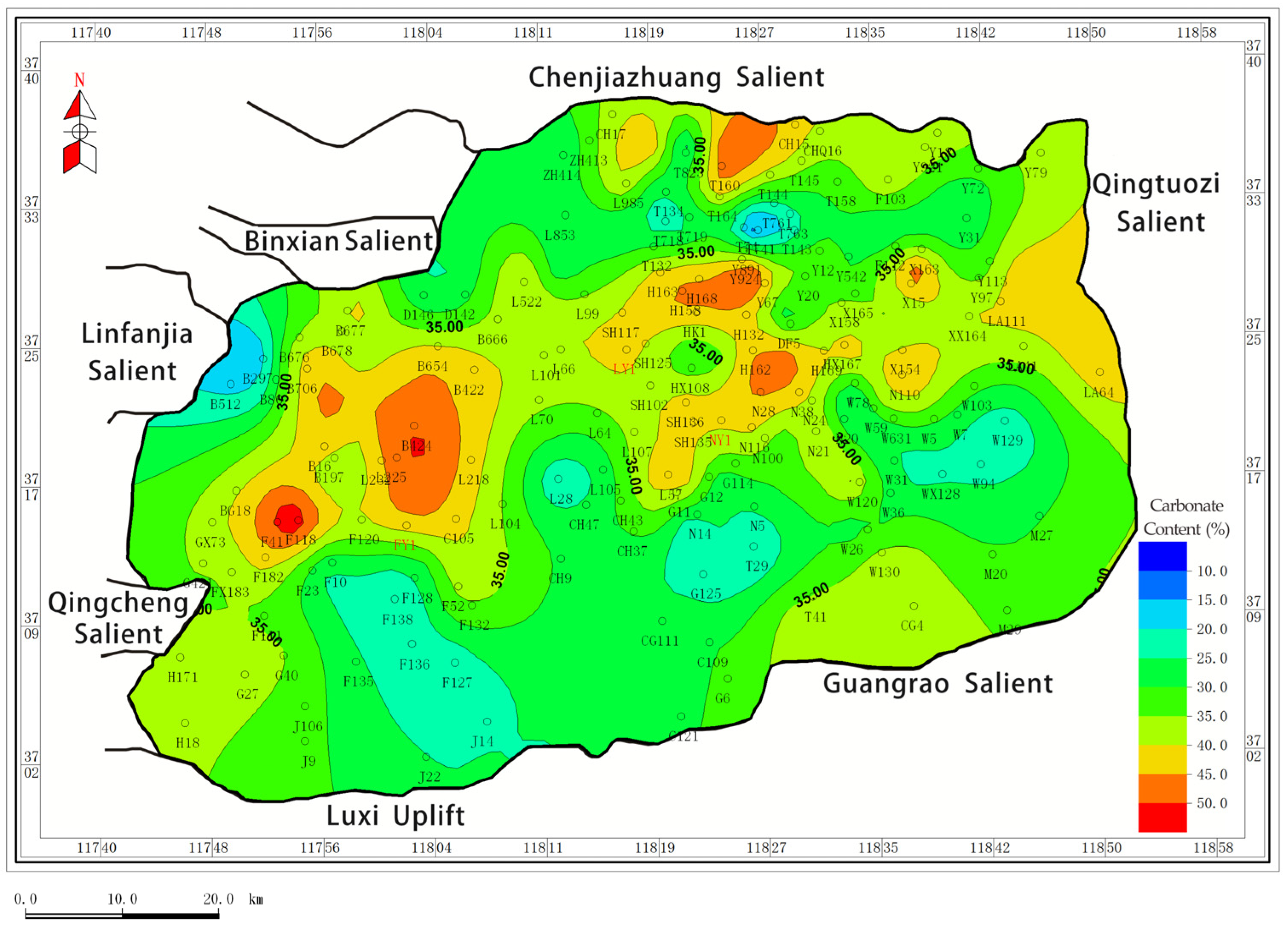
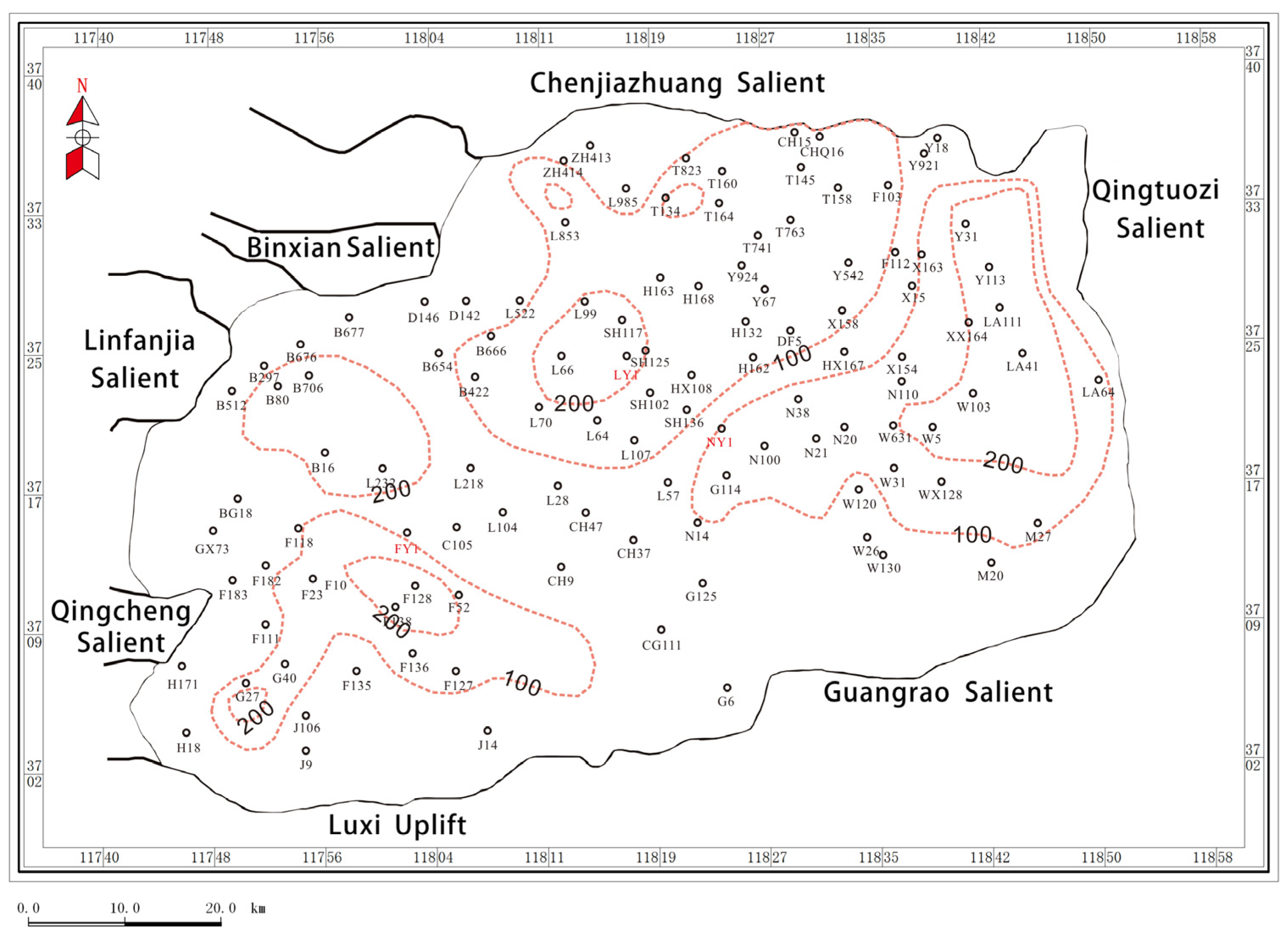
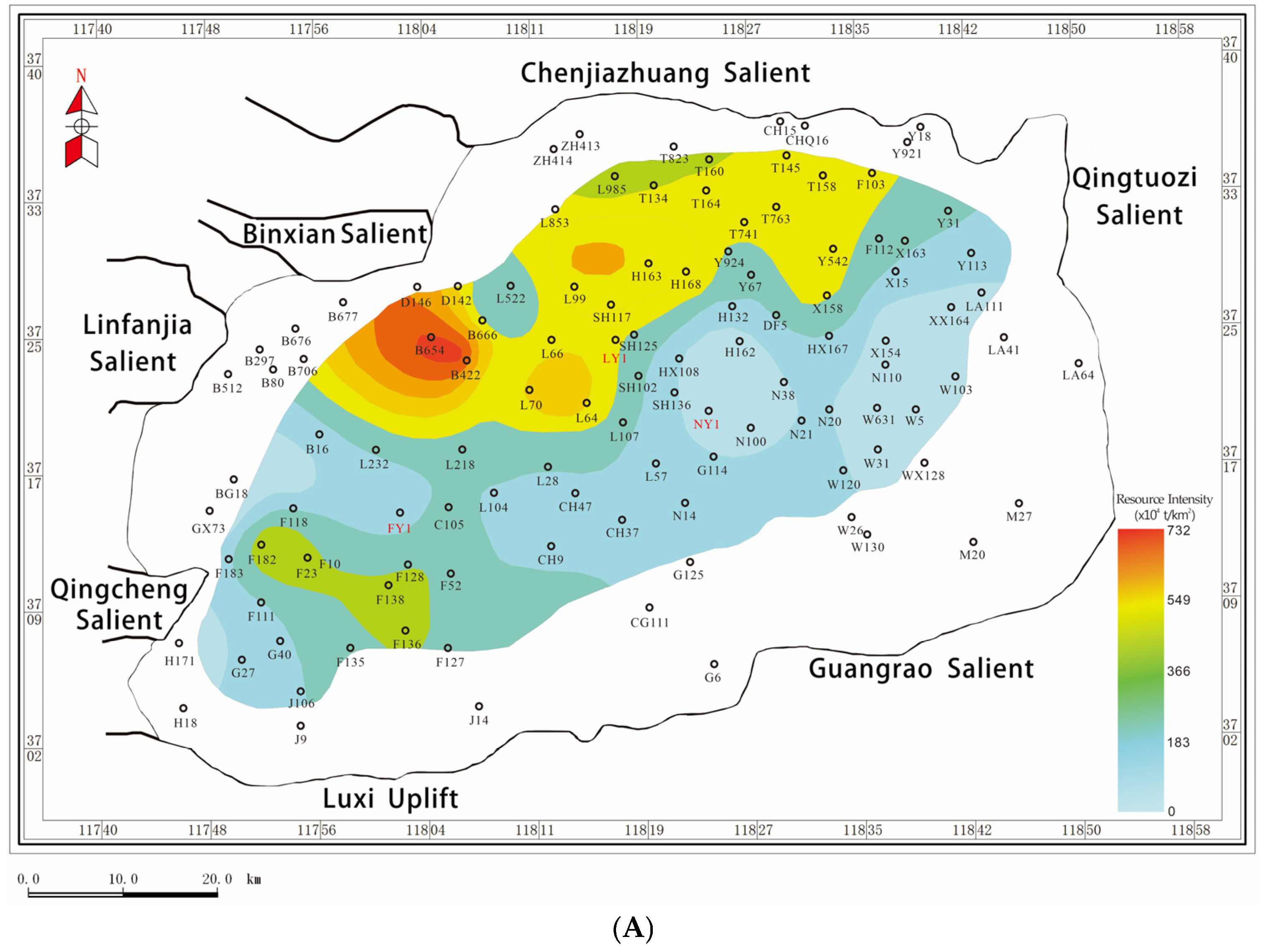

| Sr/Ba | Salinity (‰) | Sr/Ba | Salinity (‰) | Sr/Ba | Salinity (‰) |
|---|---|---|---|---|---|
| 0.54 | 3.75 | 0.33 | 0.74 | 4.28 | 17.00 |
| 0.40 | 1.37 | 0.37 | 1.89 | 3.13 | 15.00 |
| 0.64 | 3.91 | 4.06 | 15.00 | 7.05 | 19.00 |
| 0.60 | 3.58 | 2.25 | 9.50 | 6.53 | 18.00 |
| Location | PH | Ca (%) | Location | PH | Ca (%) |
|---|---|---|---|---|---|
| Qinghai Lake | 9.11 | 12.00 | Yellow Sea | 8.40 | 2.09 |
| Gahai Lake | 8.93 | 10.50 | Yellow Sea | 8.18 | 2.29 |
| Gahai Lake | 8.83 | 6.50 | Yellow Sea | 8.50 | 2.37 |
| Yellow Sea | 8.54 | 3.71 | Erhai Lake | 8.08 | 1.21 |
| Well | Samples | GR | SP | AC | DEN | R25 | CNL | CAL |
|---|---|---|---|---|---|---|---|---|
| FY1 | 843 | 0.137 | −0.135 | −0.225 | 0.019 | 0.413 | −0.295 | −0.038 |
| NY1 | 517 | 0.132 | 0.020 | 0.035 | −0.034 | 0.377 | 0.261 | −0.055 |
| LY1 | 762 | −0.135 | −0.126 | −0.173 | 0.129 | 0.264 | −0.306 | −0.047 |
Disclaimer/Publisher’s Note: The statements, opinions and data contained in all publications are solely those of the individual author(s) and contributor(s) and not of MDPI and/or the editor(s). MDPI and/or the editor(s) disclaim responsibility for any injury to people or property resulting from any ideas, methods, instructions or products referred to in the content. |
© 2025 by the authors. Licensee MDPI, Basel, Switzerland. This article is an open access article distributed under the terms and conditions of the Creative Commons Attribution (CC BY) license (https://creativecommons.org/licenses/by/4.0/).
Share and Cite
Zhao, H.; Wang, H.; Mu, N. Division of Lacustrine Environment and Significance for Shale Oil Exploration: A Case Study of the Third Member of Shahejie Formation in Dongying Sag. Energies 2025, 18, 3086. https://doi.org/10.3390/en18123086
Zhao H, Wang H, Mu N. Division of Lacustrine Environment and Significance for Shale Oil Exploration: A Case Study of the Third Member of Shahejie Formation in Dongying Sag. Energies. 2025; 18(12):3086. https://doi.org/10.3390/en18123086
Chicago/Turabian StyleZhao, He, Hongliang Wang, and Nana Mu. 2025. "Division of Lacustrine Environment and Significance for Shale Oil Exploration: A Case Study of the Third Member of Shahejie Formation in Dongying Sag" Energies 18, no. 12: 3086. https://doi.org/10.3390/en18123086
APA StyleZhao, H., Wang, H., & Mu, N. (2025). Division of Lacustrine Environment and Significance for Shale Oil Exploration: A Case Study of the Third Member of Shahejie Formation in Dongying Sag. Energies, 18(12), 3086. https://doi.org/10.3390/en18123086







